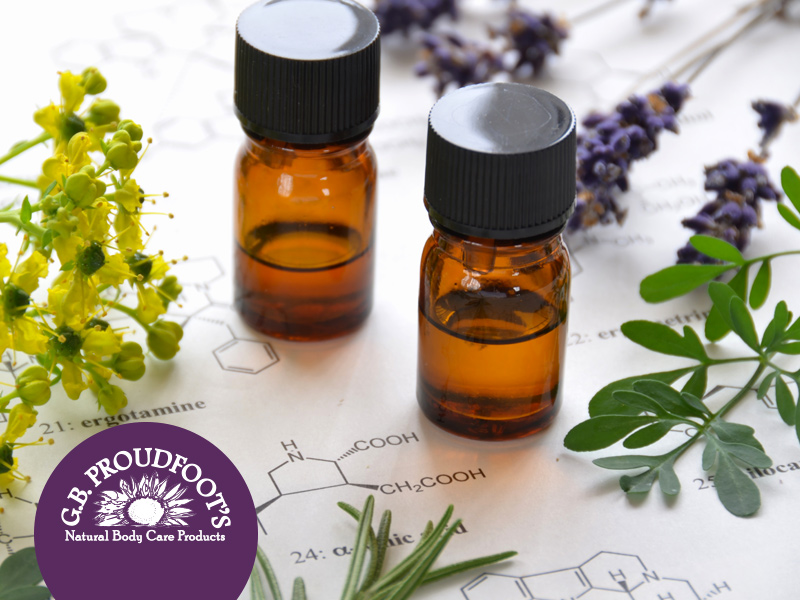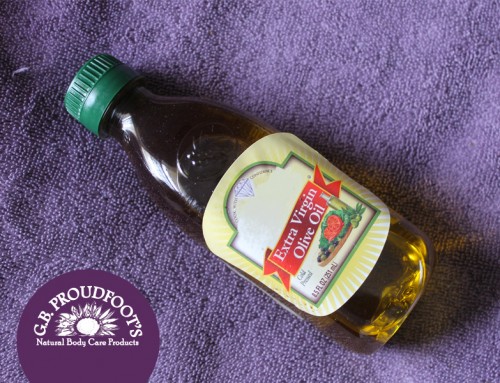If you haven’t noticed, we’ve been on a bit of a fragrance kick lately and for good reason. As you may or may not know, here at G.B. Proudfoot’s, we only use pure essential oils to scent our products. It’s part of our commitment to never use any synthetic ingredient and we are happy to realize all of the other benefits associated with using natural oils over synthetic chemicals. We catch some flack sometimes from people who are accustomed to strong synthetic fragrances or from those who request scents which just aren’t found in nature. As yummy as they may sound pina colada, fruit punch, and strawberry kiwi just aren’t available as naturally extracted scents.
What most people don’t realize is that roughly 95% of synthetic fragrance compounds are derived from petrochemicals. These chemicals are known carcinogens, hormone disruptors, and immune system suppressors, just to name a few of their nasty attributes. As we’ve mentioned in previous blogs, anytime you see the term “fragrance” on an ingredient label you could be using up to 200 additional and potentially toxic ingredients, which by law do not have to be disclosed on a label. The FDA allows for manufacturers of body and personal care products to use the term “fragrance” on their labels in order to protect proprietary formulas. So much for full disclosure, you give them an inch and they’ll take a mile. Using this loophole, manufactures can hide ingredients, many unrelated to scent, under the guise of protecting their scent formulas. We’ll pardon my sarcasm but I’m really glad they get to protect their bottom line at the expense of the public health.
Essential oils in contrast have been used for thousands of years for both scenting and therapeutic purposes. Ancient civilizations extracted the essences of the plants around them using steam distillation or presses. These were the first perfumes. Over time the extraction method has changed, sometimes not for the better with chemical solvents being used to separate the essence. The majority of high quality essential oils and the only ones we use in our products are derived from either steam or CO2 extraction or good old fashioned pressing in the case of many of the citrus oils. My point here is that these oils have been used for hundreds if not thousands of years and their properties are well documented. I’m not saying that there aren’t toxic essential oils, because there are, but we know about them and we don’t use them. This is a pretty common argument against essential oils but I think it’s a pretty lame rebuttal.
Let’s go ahead and do a couple more quick comparisons:
Cost: Essential oils are expensive, synthetic fragrances are not. While a few ounces of rose essential oil can cost in the hundreds of dollars, the same amount of a synthetic rose copy costs in the tens of dollars. Do the math, most big manufacturers have and that’s why they don’t use essential oils. They obviously don’t take into consideration the cost of your health.
Intensity: Synthetic fragrances are strong, they don’t break down easily and they last a long time. Essential oils on the other hand degrade over time, lose potency and eventually their smell. If you wanted to put your product on a store shelf or warehouse and have it sit for a few years, which would you use?
Therapeutic Use: Essential oils retain many of the therapeutic traits of the plants that they are derived from. An essential oil like the calendula EO that we use in our skin salve, stick balm, and lip balms is a great skin healer and antioxidant, lavender is great for skin irritation as well, rosemary is a known antioxidant. These are but a few examples. Aromatherapy practitioners only use essential oils for this reason. The synthetic fragrance copies simply do not have the same effects on our bodies. In fact if any synthetic fragrance had any therapeutic value we would hear about it, it would be a marketing department’s dream.
Environment Impact: I actually heard the argument the other day that synthetic fragrances were better for our environment and are in a sense “greener” because they could be produced closer to use and they did not rely on the harvesting of plant material and the destruction of sensitive plants and trees. While I admit that some plants have been exploited (sandlewood is a good example) for their essential oils I would say that the harvesting of most plants for essential oil production is done responsibly. I guess this is an argument similar to saying that products made from plastic are better for our environment and homes than those made from wood. Last time I checked wood and plants were renewable resources, crude oil is not. Picture if you will the greedy rosemary and herb farmer, ravaging the land to satisfy the world’s hunger for herbs, while the mild mannered chemist sits in his lab synthesizing herb flavor compounds from petrochemicals. Thanks science! OK maybe I’m getting carried away but I think you can see the problems with this one, I do give them extra marks for trying though 🙂
Hopefully we’ve provided a little more information and education on this well kept secret and little publicized debate. In our minds and hopefully yours, essential oils are the big winners here. As we become more conscious of what we are putting in our bodies and on our skin more troubling information is bound to come out about the effects these petrochemicals are having on our lives. If we don’t have our health, all else matters very little. As always, we encourage you to read your labels and if you haven’t made the switch to natural and organic body care products yet, we think you’ll be pleasantly surprised when you do. Here at G.B. Proudfoot’s where we only use 100% natural and time tested ingredients we’re trying to fight the good fight, with your help we think we can change a few minds and bodies 🙂







Leave A Comment